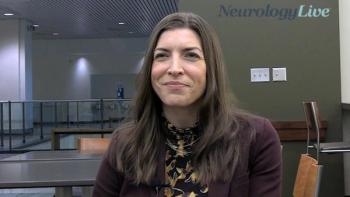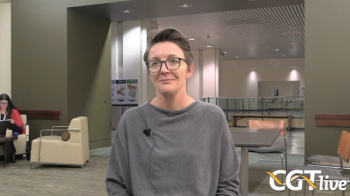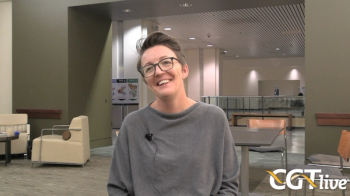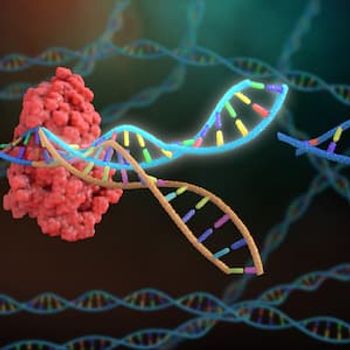
Gene Signatures Predict for Radiation Response in Breast Cancer
Recent studies have demonstrated that somatic mutations of ATM denote greater response to radiation therapy and that gene patterns may help predict the timing of recurrence following radiation.
Sumanta K. Pal, MD
In breast cancer, genetic signatures have been used to predict response to chemotherapy and hormone treatment, as well as risk of metastasis. Their utility as predictors of response to radiation has been unclear. However, recent studies have demonstrated that somatic mutations of ATM denote greater response to radiation therapy and that gene patterns may help predict the timing of recurrence following radiation.
“There are several commercially available platforms that are used in different clinical settings to predict recurrence after treatment,” said Sumanta K. Pal, MD, an expert commentator for the American Society of Clinical Oncology (ASCO). “One prominent example is the Oncotype DX recurrence score test, which helps guide the decision for adjuvant chemotherapy in breast cancer. The role of this platform is well established through randomized trials. Similarly, there are several molecular tools in prostate cancer [Decipher and Oncotype DX AR-V7 Nucleus Detect] that aid in predicting outcome following definitive treatment. However, clinicians are somewhat divided on the utility of these tools.”
Somatic Mutations of ATM
Studies are underway to identify specific gene mutations associated with the response to radiation therapy. Previous findings suggest that mutations of genes involved in DNA repair, such as BRCA1/2 and ATM, may contribute to chemotherapy resistance and a poor prognosis, but may also denote sensitivity to radiation therapy. In a study presented at ASCO’s Breakthrough: A Global Summit for Oncology Innovators, held in October 2019 in Bangkok, investigators sought to determine whether tumors with BRCA1/2 or ATM mutations were more susceptible to radiotherapy.1 They concluded that ATM mutations confer “exceptional responses to radiation therapy,” offering potential for therapeutic value.
Table 1. Somatic Mutations in ATM Gene Confer Response to RT1 (Click to Enlarge)
Because radiation works by damaging DNA, a DNA damage repair gene, such as ATM, that malfunctions may confer sensitivity of a tumor to radiation treatment. “In this context, our study showed that the ATM gene (a DNA damage-repair gene) may serve as a novel mutation-based marker of radiosensitivity [and] could be harnessed for personalized treatment in the future,” said Jason Joon Bock Lee, MD, of Yonsei Cancer Center in Seoul, South Korea.
Such findings may have utility in tumor types other than breast cancer, according to Pal, a specialist in urologic cancers and codirector of the Kidney Cancer Program at City of Hope in Duarte, California. ATM or other genes involved in DNA repair may predict outcomes following radiation therapy in patients with prostate cancer, he said. “We are increasingly becoming aware of the role of DNA repair in prostate cancer, with agents such as olaparib [Lynparza], a PARP inhibitor, demonstrating efficacy in advanced disease.”
Avoiding Unnecessary Treatment
Predicting radiation response may spare women with breast cancer from unnecessary exposure to this treatment. For women who undergo lumpectomy plus radiation therapy, the chance of local recurrence in 10 years is roughly 3% to 15%.2,3 Some women are cured with surgery and possibly endocrine therapy following surgery, however, and do not need the radiation therapy.
Table 2. A Gene Signature for RT Response7 (Click to Enlarge)
In a cohort of 134 patients with locally advanced breast cancer, 192 genes were identified with significantly different expression between tumors responsive to radiation and those nonresponsive tumors.4 Among these, MAP3K4 was validated as a radiation therapy—specific predictive biomarker of distant metastasis-free survival in the pre- and postoperative settings and as a potential target for radiosensitizing combination therapy, warranting additional investigation and prospective clinical validation.
A study of 94 samples from 77 patients with invasive breast cancer failed to identify any clinically significant differences in gene expression between patients with and without a response to radiation therapy.5 However, investigating samples before and after radiation therapy revealed significant upregulation of genes involved in apoptosis, p53 signaling, TNFA1 signaling, epithelial mesenchymal transition, and inflammatory response, whereas genes involved in G2-M checkpoint, mitotic spindle, and E2F targets were downregulated.
Predicting Early Versus Late Recurrence
At the ASCO Breakthrough meeting, Speers presented a gene pattern that may be used to predict the timing of recurrence following radiation therapy, based on a radiation response signature comprising 27 genes that identified women who are likely to have a locoregional recurrence despite surgery and radiation (HR, 3.4; 95% CI, 2.0-5.9; P <.001).6
“That signature allowed us to identify which of those women they were, but it didn’t tell us anything about the timing of that recurrence,” Speers said. “We know that recurrences can come early; they can come late. There are some differences in outcomes depending on whether they are early versus late recurrence.”
Therefore, a study extension was designed to determine whether postradiation recurrences were going to occur early in the first 3 years after treatment or after 3 years (late).
In the current study, investigators included training (n = 119) and validation (n = 112) cohorts of patients who underwent radiation therapy after breast-conserving surgery and systemic therapy as appropriate (Table 2).7 Overall, they identified a signature of 41 genes with expression that was significantly associated with recurrence time. Further analyses identified genes related to EGFR signaling associated with early recurrences and genes related to estrogen receptor (ER) signaling associated with late recurrences.
Speers explained that these findings have implications for risk stratification related to therapy intensification and for continued screening and clinical follow-up, specifically for patients who are predicted to have late recurrences. “Often, we’ll follow a patient for the first 3 to 5 years, and then we’ll have them go back to their primary care doctor to continue routine follow-up,” he said. “If a woman, based on the genetics of her tumor, is predicted to have a late recurrence, we might need to think about screening this patient or following her in an oncology clinic a little bit longer.”
This study also uncovered some of the biology that may be underlying the early, aggressive recurrences and the late recurrences. “Not surprisingly, the late recurrences seem to be driven by an ER signaling-mediated pathway,” Speers said. “We’ve known for a long time that estrogen can drive breast cancer. When they’re strongly ER driven, breast cancers tend to be less aggressive, and that’s what we saw in these patients predicted to have late recurrences.”
However, the early recurrences all seemed to have genes associated with the EGFR signaling pathway. “That might be a vulnerability that we can potentially exploit to treat women with the early-recurring, more aggressive tumors,” Speers said.
Future Considerations
Findings from these studies require validation and confirmation in larger populations. According to Speers, the unanswered question is, will any of these signatures will be validated using additional datasets or in phase III, randomized trials designed to evaluate response to radiation?
“We think there’s a lot of promise with our test, and there are a couple of other tests that have been developed in this space—they all look very promising—but none of them [has] been externally validated in multiple randomized phase III trials,” Speers said. “That’s the real litmus test and that’s where we’re going right now. We’re not quite there yet, but in the next 3 to 5 years, I anticipate these tests making their way into the clinic.”
Pal agreed, noting, “These results are compelling but early—external and, ideally, prospective—validation will be required to demonstrate the utility of these approaches.”
Currently, there are 2 approved tests, including the Oncotype DX DCIS and DCISionRT recurrence score tests, for decision making related to radiation therapy for women with ductal carcinoma in situ (noninvasive breast cancer). According to Speers, the availability of tests for women with invasive disease will be coming soon.
“Subject to some additional validation findings, I think all clinicians and patients should be very excited that we’re about to enter the personalized era for radiation treatment decisions,” Speers said. “We’ve been there for 10 years now with chemotherapy, and I think we’re very close to being there with radiation therapy decision making, and that’s an exciting time.”
References
- Lee JJB, Yang AJ, Chang JS, et al. Genomic analysis reveals somatic mutations of ATM gene in DNA repair confer exceptional target lesion response to radiation therapy. J Glob Oncol.2019;(suppl 5; abstr 130). doi: 10.1200/JGO.2019.5.suppl.130.
- Arvold ND, Taghian AG, Niemierko A, et al. Age, breast cancer subtype approximation, and local recurrence after breast-conserving therapy. J Clin Oncol. 2011;29(29):3885- 3891. doi: 10.1200/JCO.2011.36.1105.
- Braunstein LZ, Taghian AG, Niemierko A, et al. Breast-cancer subtype, age, and lymph node status as predictors of local recurrence following breast-conserving therapy. Breast Cancer Res Treat. 2017;161(1):173-179. doi: 10.1007/s10549-016-4031-5.
- Tanić M, Krivokuća A, Čavić M, et al. Molecular signature of response to preoperative radiotherapy in locally advanced breast cancer. Radiat Oncol. 2018;13(1):193. doi: 10.1186/s13014-018-1129-4.
- Bosma SCJ, Hoogstraat M, van der Leij F, et al. Response to preoperative radiation therapy in relation to gene expression patterns in breast cancer patients [published online September 13, 2019]. Int J Radiat Oncol Biol Phys. doi: 10.1016/j.ijrobp.2019.09.002.
- Sjöström M, Chang SL, Fishbane N, et al. Clinicogenomic radiotherapy classifier predicting the need for intensified locoregional treatment after breast-conserving surgery for early-stage breast cancer [published online October 16, 2019]. J Clin Oncol. doi: 10.1200/JCO.19.00761.
- Speers CW, Chang SL, Chandler B, et al. A signature predictive of early versus late recurrence after radiation (RT) for breast cancer that may inform the biology of early, aggressive recurrences. J Glob Oncol. 2019;(suppl5 ; abstr 112). doi: 10.1200/JGO.2019.5.suppl.112.
“Our group has been very interested in using genetic or transcriptomic tests to serve as biomarkers that can predict which women are going to benefit from radiation and which women aren’t going to derive that benefit,” said Corey W. Speers, MD, PhD, an assistant professor of radiation oncology at Michigan Medicine in Ann Arbor.
Among a cohort of 134 patients who underwent radiation therapy for gross disease and next-generation sequencing panel screening between 2013 and 2019, somatic ATM (n = 11) or BRCA1/2 (n = 22) mutations were identified in 33 patients, and 33 patients without mutations were matched using propensity scoring based on histology and radiation dose.1 The overall response rate, local control rate, and infield complete response rate were significantly higher in patients with an ATM mutation compared with patients with no ATM mutation (Table 1 1). The duration of response was significantly prolonged in patients with ATM mutations compared with those with no ATM mutation (median, 11 vs 3 months; P = .001). Importantly, radiation therapy—related toxicities were similar between patients with mutations and those without (17% vs 11%, P = .515), and no severe toxicities were reported.
Newsletter
Stay at the forefront of cutting-edge science with CGT—your direct line to expert insights, breakthrough data, and real-time coverage of the latest advancements in cell and gene therapy.










































